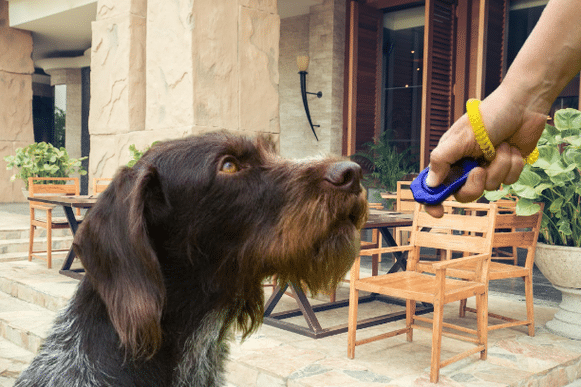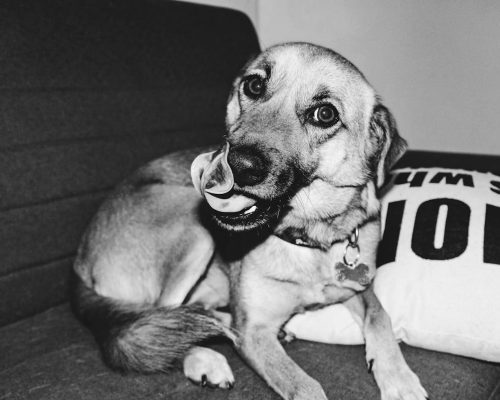Among the myriad of training techniques, clicker training stands out as a positive and effective method that works across all breeds and ages.
Training your dog is a cornerstone of responsible pet ownership, helping to build trust, communication, and a harmonious relationship.
It relies on a simple device, a clicker, to signal to your dog when they’ve done something right, followed by a reward. This method is rooted in science, emphasizing the power of timing and reinforcement.
In this guide, we’ll explore the ins and outs of clicker training, providing you with the tools to get started and succeed.
Table of Contents
ToggleWhat is Clicker Training?
Clicker training is a training approach rooted in positive reinforcement. At its core, it involves using a handheld device that emits a distinct clicking sound.
The clicker acts as a marker, precisely signaling the moment your dog performs a desired behavior. This method shifts the focus from punishment to rewards, emphasizing encouragement rather than correction.
Unlike yelling or leash pulling, which can create fear or confusion, clicker training fosters a clear understanding of what is expected. Dogs quickly learn to associate the click sound with rewards, motivating them to repeat positive behaviors.
The Science Behind Clicker Training
Clicker training is grounded in operant conditioning, a learning process studied extensively by behavioral psychologists. This principle involves creating associations between actions and consequences.
The clicker serves as a secondary reinforcer, meaning it’s a signal that a primary reward—like a treat or toy—is on its way. Timing is critical: the click must occur at the exact moment the desired behavior happens.
This precision makes it easier for dogs to understand what behavior earned them the reward, speeding up the learning process.
Benefits of Clicker Training
Precision
The clicker’s consistent sound ensures that your dog receives immediate feedback. Unlike verbal cues, which can vary in tone or clarity, the click is always the same, eliminating confusion.
Speed
Dogs are highly responsive to the click-reward sequence. This efficiency allows you to teach new commands or behaviors faster than many other methods.
Versatility
Clicker training isn’t limited to basic commands. It can be used for tricks, advanced agility training, or even addressing behavioral challenges like excessive barking or chewing.
Strengthened Bond
Training with positive reinforcement enhances trust between you and your dog. It creates a fun and rewarding experience for both parties, deepening your bond.
Getting Started with Clicker Training
Choosing the Right Clicker
Clickers vary in size and design, but the primary factor is comfort and sound clarity. Some models come with wrist straps for convenience, while others offer softer clicks for noise-sensitive dogs.
Preparing Your Supplies
Gather high-value treats that your dog loves, such as small pieces of cheese or cooked chicken. Ensure you have a quiet, distraction-free environment for the initial sessions. A treat pouch can also keep rewards accessible without fumbling.
Introducing the Clicker
Before diving into commands, you need to “charge” the clicker. This step involves teaching your dog that the click sound means a reward is coming.
- Sit with your dog in a calm space.
- Click the device and immediately offer a treat.
- Repeat this process 10–15 times in short intervals.
You’ll know your dog understands the association when they perk up or look at you expectantly upon hearing the click.
Teaching Basic Commands with Clicker Training
Sit
To teach your dog to sit, hold a treat close to their nose and slowly lift it upwards. As their head follows the treat, their bottom will naturally lower to the ground. The moment they sit, click and reward.
Stay
Begin with your dog in a sitting position. Hold your hand up in a “stop” gesture and say “stay.” After a second or two, click and reward if they don’t move. Gradually extend the time before clicking to reinforce the behavior.
Using Clicker Training for Behavioral Issues
Excessive Barking
When your dog pauses barking, immediately click and reward. This teaches them that being quiet brings positive outcomes. Consistency is key to reinforcing this behavior.
Jumping on Guests
If your dog jumps on guests, train them to sit as an alternative behavior. Click and reward as soon as they sit calmly when someone arrives. Over time, they will understand that calmness earns them rewards.
Tips for Effective Clicker Training
- Be Consistent: Always click at the exact moment of the desired behavior. Consistency builds reliable habits.
- Short Sessions: Dogs have short attention spans. Aim for 5–10 minutes per session to keep them engaged.
- High-Value Rewards: Use treats that your dog finds irresistible, especially in the beginning stages.
- Patience is Key: Every dog learns at their own pace. Stay positive, even if progress feels slow.
Common Mistakes to Avoid
Clicking Too Late
Timing is everything. If the click comes too late, your dog won’t associate it with the intended behavior. Practice your timing to ensure effectiveness.
Overusing the Clicker
Once your dog masters a command, transition to verbal praise and intermittent rewards. Over-reliance on the clicker can diminish its impact.
Skipping Rewards
The click alone isn’t enough. Without a reward, the association weakens, and your dog may lose interest.
Expanding Beyond Basic Commands
Advanced Tricks
Clicker training opens the door to advanced tricks like rolling over, playing dead, or retrieving specific items. Break each trick into smaller steps, clicking and rewarding at every successful stage.
Agility Training
For active breeds, agility training can be a fantastic outlet for their energy. Use the clicker to mark successful navigation of obstacles, such as jumps or tunnels.
Clicker Training for Puppies vs. Adult Dogs
Puppies are naturally curious and eager to learn, making them ideal candidates for clicker training. However, adult dogs can also excel with patience and persistence. While older dogs may take longer to grasp new concepts, the principles remain the same, and the results are just as rewarding.
Transitioning Away from the Clicker
As your dog becomes proficient in commands, you can phase out the clicker. Replace it with verbal cues and continue to reward good behavior sporadically. This transition ensures the behaviors remain consistent without over-dependence on the device.
Conclusion
Clicker training is a powerful tool for building a well-behaved and happy canine companion. By emphasizing positive reinforcement, clear communication, and mutual respect, this method creates a learning environment that benefits both you and your dog.
Whether you’re teaching basic commands or advanced tricks, clicker training is a rewarding journey that enhances your bond and enriches your dog’s life. Start today, and watch your dog’s potential unfold!






